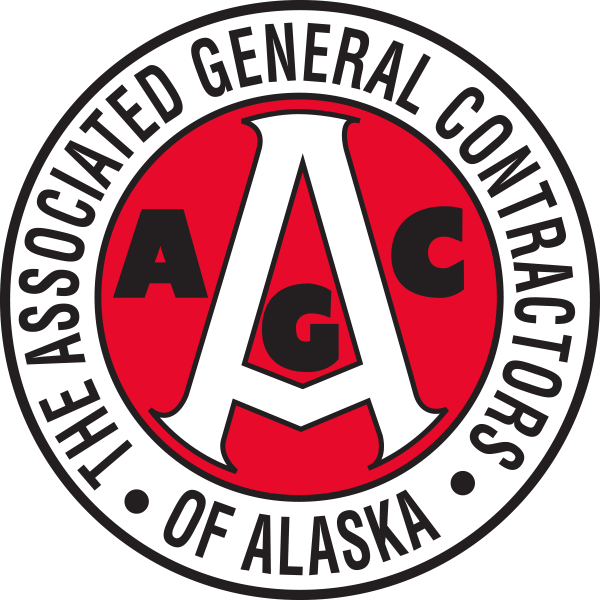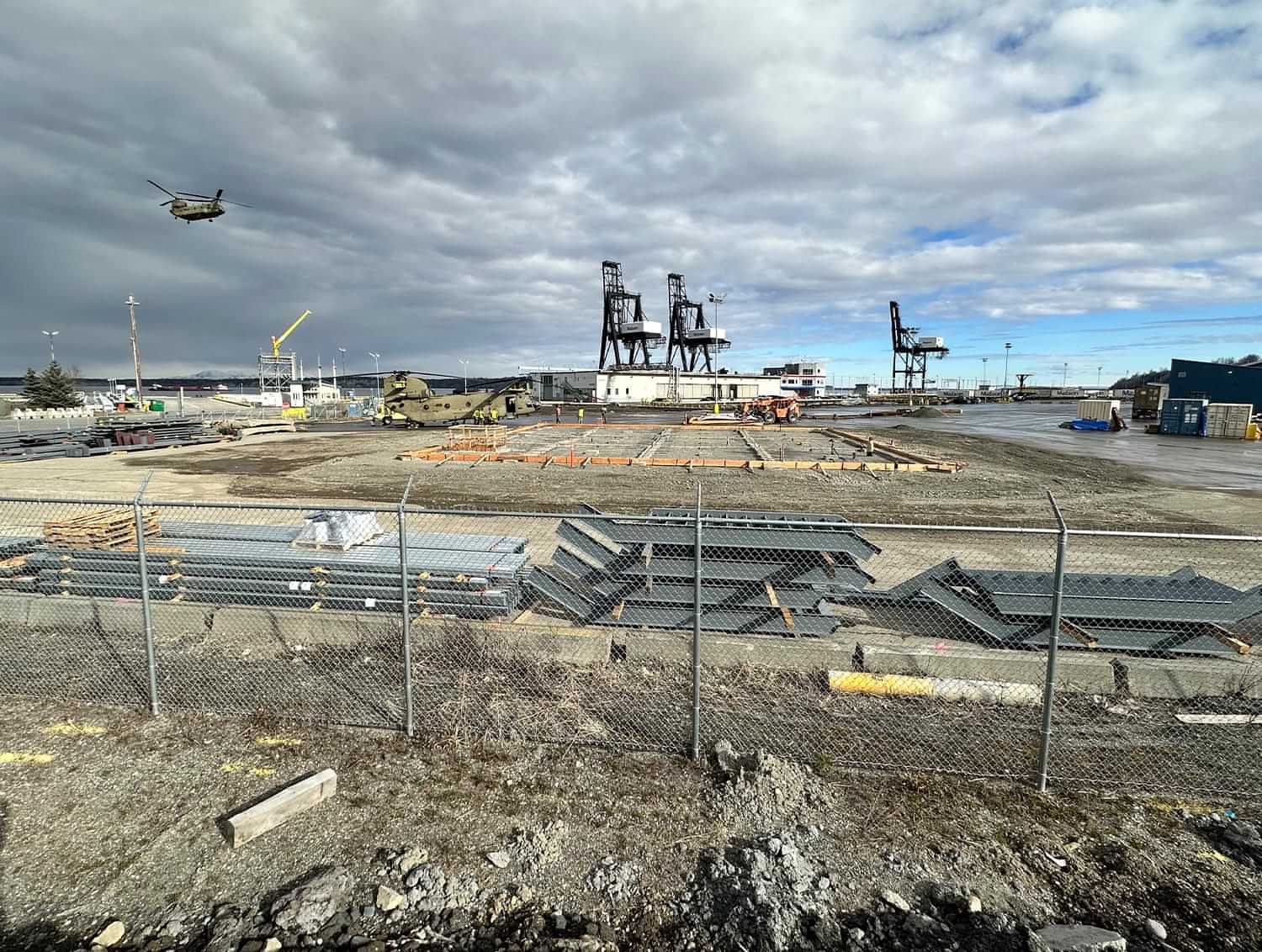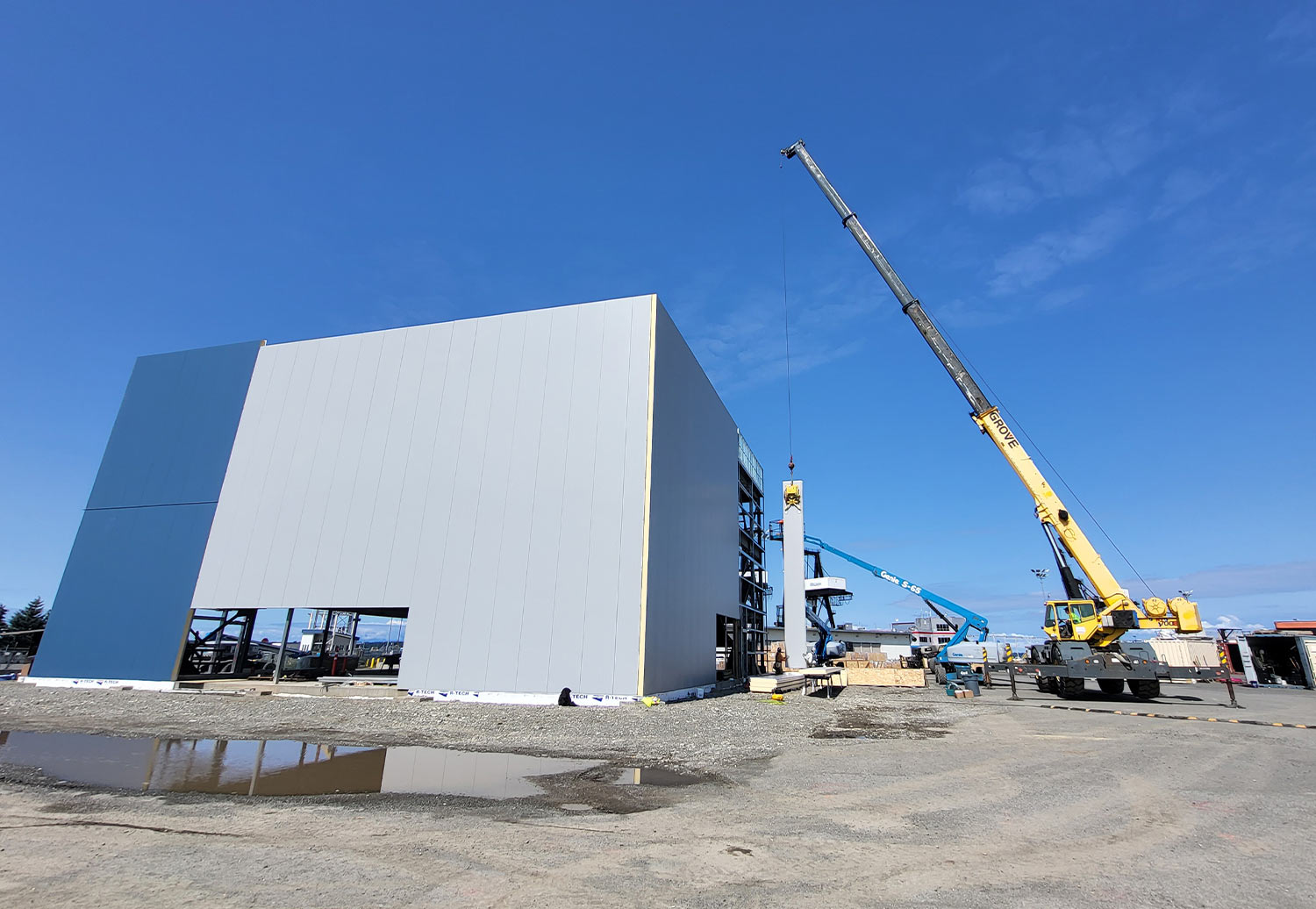
Update
Port
Progress
Phase one complete,
more projects are
in process
By Terri Marshall
An STG Pacific employee watches as structural steel is raised on the Port of Alaska administration building earlier this year.
Port Progress
ort of Alaska has served Alaska communities for more than six decades. Businesses, military personnel, and residents rely heavily on the port for access to supplies including building materials, cars, consumer goods, and food.
“Port of Alaska has three core functions,” explained Port of Alaska Deputy Director Jim Jager. “It supports local, statewide and national commerce by enabling efficient fuel and cargo shipping into, around and out of Alaska. It is one of eighteen US commercial strategic seaports that supports Defense Department missions in Alaska and around the world. And it is critical infrastructure that government agencies need to provide timely and effective response to major natural disasters—think earthquakes—in Southcentral and most of Alaska.”
PAMP has four basic goals: to replace aging docks and related infrastructure; to improve operational safety and efficiency; to accommodate modern shipping operations and technologies; and to improve resiliency to survive extreme seismic events and Upper Cook Inlet’s harsh marine environment.
“It’s important for people to understand that the PAMP is a modernization program, not an expansion program,” Jager says. “The new docks will be about the same length as the old docks, probably a little shorter. But they will be built to modern seismic standards and with deeper berths and wider decks that support larger cranes needed to service the larger cargo vessels that dominate today’s shipping market.”

A Boeing CH-47 Chinook heavy-lift helicopter flies overhead as the foundation is prepared for the Port of Alaska administration building earlier this year.
First Step Complete
The first step in the replacement project, the Petroleum and Cement Terminal, was completed last fall. The second step, North Extension Stabilization Step 1, or NES1, is under way.
NES1 is actually a demolition and removal project. It will remove filled uplands that were improperly constructed in the early 2000s that are prone to seismic failure and could close ship berths or damage or destroy existing cargo terminals during a major earthquake. It will also create vessel maneuvering space needed to maintain safe operations at existing cargo terminal 3 while the new cargo terminals are being built. The project is expected to reduce the volume of maintenance dredging needed to maintain Port of Alaska operations. NES1 is currently under construction, with in-water demolition scheduled to begin in spring 2024.
Seattle-based Manson Construction is the primary contractor on the $97.5 million design-build NES1 contract. Subcontractors include AGC member companies Granite Construction and Edge Survey and Design, LLC.
“The challenge, as we move forward, is the need to keep all of our docks open the whole time as we build new docks,” Jager explains. “Our strategy is to build the first new dock south of the existing docks and then move north with a demolish, build, demolish, build plan that will maintain operational cargo capacity throughout the whole project.”
Another key part of the replacement project is creating a safe navigation system.

Under a blue sky, early work is done on the Port of Alaska administration building.
Subcontractors working with STG Pacific on this project include the following AGC member companies:
KLEBS Mechanical, Inc. • Excel Construction, Inc.
Allied Steel Construction, Inc.
Alaska Demolition, LLC • RIM Architects, LLC

A New Administrative Office Underway
“Our office building is located on Cargo Terminal 1,” Jager says. “Before the dock can be demolished, the building has to be rebuilt in a new location.”
Associated General Contractors, or AGC, of Alaska member STG Pacific, or STGP, is involved in this phase of the port project.
“The existing port administration building is located out on the pier,” STGP Senior Project Manager Mack Pennington explains. “The new building we’re constructing will be more resilient and will be on the shore side but still near the terminal.”
The new administration building is 16,919 square feet, spanning three floors. It features an observation deck, modern fire suppression, elevator access, an open floorplan and covered parking for staff.
“At STGP, we are thrilled with the strong partnership we have formed with the Port of Alaska, Jacobs Engineering, and our design team at RIM architects to develop the building design, fast-track the civil and foundation work, and construct the project with an estimated spring 2024 completion,” Pennington says. “Superintendent Pat Zajac, Quality/Estimating Manager Chase Swalling and Site Safety and Health Officer Josh James anchor our dedicated onsite staff. We are proud to support the Port of Alaska and contribute to their critical mission.”

The outer shell is being placed on the new Port of Alaska administrative building.
Funding the Remaining Port of Alaska Projects
As the various phases of work at the Port of Alaska unfold, funding continues to dictate timing.
“This is a complicated project and there is no one funding source that’s going to pay for the project; it takes a combination of sources,” Jager says. “Some will be federal grants, some from state grants, and some will come from Port of Alaska bonds sold to investors which will be repaid with revenue from the port tariffs, etc.”
Of course, estimating costs for future phases of the project isn’t easy.
“For the additional phases we have a concept for the cargo terminals, but we don’t have a mature enough design so that we can talk about the precise costs,” Ribuffo says. “The initial numbers will come from our various planners and designers, but the final very specific number won’t arrive until we are advertising the project.”
Although the projects at the Port of Alaska warrant multiple strategies for funding, most Alaskans understand the necessity and the funding required to complete the projects.
“Overall, people understand. I see it in my travels when we engage with the public and give a lot of presentations,” Ribuffo shares. “Everyone appreciates it. After all, we all benefit from the Port of Alaska being here.”
For Pennington, working on the Port of Alaska project is personal. “I’m happy to be working on this project in the same city where our business is headquartered. Anchorage is my hometown and it’s an exciting opportunity to contribute to the betterment of the Port of Alaska as it touches every aspect of our everyday lives.”